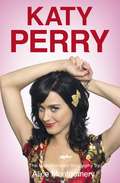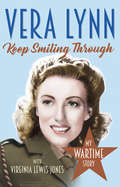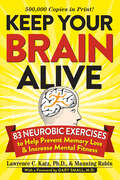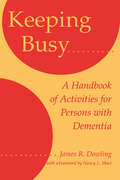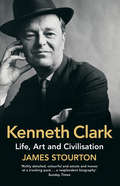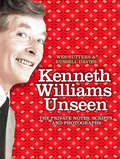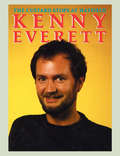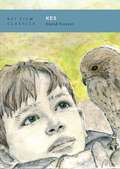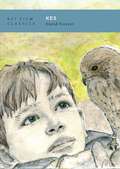- Table View
- List View
Katy Perry: California Gurl
by Jo BerryLifting the lid on the chart-topping, girl-kissing, trend-setting princess of popIn 2006, Katy Perry was on the brink of packing it all in and giving up - Hollywood had almost got the better of her. Two hit albums later and she practically owns the place. The gorgeous singer, best known for her flirty hit 'I Kissed a Girl', likes to flaunt her feminine side with inch-long eyelashes, maraschino-cherry lips, and playful retro outfits like polka-dotted hot pants and tube dresses, but Katy's path to fame was far bumpier than her glamtastic image lets on. Raised in Santa Barbara, California, she started her musical career in the church, her parents were both born-again Christian pastors. Her first album, released in 2001, was Christian gospel and the rules for her early years were 'no pop, no snacks, no boys'. At 16 she dropped out of high school and made the move to L.A., and her life was forever changed. It took more than eight years of false starts, winning and losing three record contracts, before she scored the million-selling album One of the Boys. But once `Ur So Gay' was declared by Madonna as her song of the year, 'I Kissed a Girl' ignited all that controversy, and Katy met her husband-to-be Russell Brand and so became one half of one of the most exciting and endearing Hollywood couples, Katy Perry was propelled to the top of the Hollywood A list.Jo Berry's insightful and honest biography reveals the incredible story of the life and loves of the artist and performer Katy Perry.
Katy Perry: The Unofficial Biography
by Alice MontgomeryThe fascinating account of a girl-next-door turned pop princessEver since the international chart-topping hit, I Kissed a Girl, Katy Perry hasn't stopped making headlines. From reaching number one in charts worldwide to selling out concerts around the globe, her phenomenal success has propelled her to the A-list. But it didn't always seem like she was destined for stardom. Brought up in a deeply religious community, Katy was allowed to listen only to church music. However, with her astounding musical gift, along with plenty of willpower, Katy was determined to follow her dream. Her rise to the top was cemented in 2010, when after a flurry of media gossip, she married the most controversial figure on British TV - Russell Brand. Bestselling biographer Alice Montgomery traces Katy's steps to stardom from her choir girl beginnings to her breakthrough in the music business and her secret wedding ceremony in India, to reveal the intimate story behind the most exciting and unpredictable pop star around.
Keep Moving: And Other Tips and Truths About Aging
by Dick Van DykeShow-business legend Dick Van Dyke is living proof that life does get better the longer you live it. Who better to offer instruction, advice, and humor than someone who's entering his ninth decade with a jaunty two-step? Van Dyke isn't just a born song-and-dance man; his irrepressible belief in embracing the moment and unleashing his inner child has proved to be the ultimate elixir of youth. When he was injured during the filming of Chitty Chitty Bang Bang, his doctor warned him he'd be using a walker within seven years, but Dick performed a soft shoe right there and never looked back.In Keep Moving, Dick Van Dyke offers his own playful anecdotes and advice, as well as insights from his brother, actor Jerry Van Dyke; his friend and creator of The Dick Van Dyke Show, Carl Reiner; and other spirited friends and family. Whether he's describing the pleasure he takes in his habitual visits to the grocery store; how he met his late-in-life-love Arlene; or how he sprung back, livelier than ever, from a near-death experience, Dick's optimistic outlook is an invigorating tonic for anyone who needs a reminder that life should be lived with enthusiasm despite what the calendar says."You don't have to act your age. You don't even have to feel it. And if it does attempt to elbow its way into your life, you do not have to pay attention. If I am out shopping and hear music playing in a store, I start to dance. If I want to sing, I sing. I read books and get excited about new ideas. I enjoy myself. I don't think about the way I am supposed to act at my age - or at any age. As far as I know, there is no manual for old age. There is no test you have to pass. There is no way you have to behave. There is no such thing as 'age appropriate.'When people ask my secret to staying youthful at an age when getting up and down from your chair on your own is considered an accomplishment, you know what I tell them?'Keep moving.'”- Dick Van Dyke
Keep Moving: And Other Tips and Truths About Aging
by Dick Van DykeShow-business legend Dick Van Dyke is living proof that life does get better the longer you live it. Who better to offer instruction, advice, and humor than someone who's entering his ninth decade with a jaunty two-step? Van Dyke isn't just a born song-and-dance man; his irrepressible belief in embracing the moment and unleashing his inner child has proved to be the ultimate elixir of youth. When he was injured during the filming of Chitty Chitty Bang Bang, his doctor warned him he'd be using a walker within seven years, but Dick performed a soft shoe right there and never looked back. In Keep Moving, Dick Van Dyke offers his own playful anecdotes and advice, as well as insights from his brother, actor Jerry Van Dyke; his friend and creator of The Dick Van Dyke Show, Carl Reiner; and other spirited friends and family. Whether he's describing the pleasure he takes in his habitual visits to the grocery store; how he met his late-in-life-love Arlene; or how he sprung back, livelier than ever, from a near-death experience, Dick's optimistic outlook is an invigorating tonic for anyone who needs a reminder that life should be lived with enthusiasm despite what the calendar says. "You don't have to act your age. You don't even have to feel it. And if it does attempt to elbow its way into your life, you do not have to pay attention. If I am out shopping and hear music playing in a store, I start to dance. If I want to sing, I sing. I read books and get excited about new ideas. I enjoy myself. I don't think about the way I am supposed to act at my age - or at any age. As far as I know, there is no manual for old age. There is no test you have to pass. There is no way you have to behave. There is no such thing as 'age appropriate.' When people ask my secret to staying youthful at an age when getting up and down from your chair on your own is considered an accomplishment, you know what I tell them? 'Keep moving.'" - Dick Van Dyke
Keep Smiling Through: My Wartime Story
by Dame Vera Lynn Virginia Lewis-JonesIn the year of her 100th birthday, Dame Vera Lynn's fascinating and life-affirming wartime memoir from the forces' sweetheart's of her adventures entertaining the troops in far-flung Burma.'I was just twenty-seven years old when I went to Burma. It was an experience that changed my life for ever. Up until that time I had not really travelled anywhere at all, apart from one touring visit to Holland with a band I was singing with before the war, and I had certainly never been in an aeroplane. But I wanted to make a difference, to do my bit.'And she did.Written with her daughter, Virginia Lewis-Jones this is a powerful and life-affirming account of the time she spent with troops in wartime Burma. Based, in part on a diary she kept, alongside unpublished personal letters and photographs from surviving veterans and their families, it explores why it was such a life-defining event for her and shows how her presence helped the soldiers, airmen and others who heard her sing.
KEEP THE FAITH: A MEMOIR
by Faith Evans"Forceful talent" (Essence Magazine) and R&B sensation Faith Evans gives us a first person account of life at ground zero of the most infamous part of hip-hop history. It's been over ten years since Big was killed. I grieved for him for a very long time. And then, as time passed, the icy wall of grief surrounding my heart began to thaw and I began to heal. I remarried, had more children, and continued to record and release more music. I continued to live my life. And while I can never discount the time I spent with Big, I've never felt the need to live in the past. But sometimes, I still find myself thinking about Big being rushed the hospital, and I break down in tears. It's not just because we hung up on each other during what would be our last telephone conversation. And it's not because I am raising our son, a young man who has never known his father. It's partly all of those things. But mainly it's because he wasn't ready to go. His debut album was called Ready to Die. But in the end, he wasn't. Big never got a chance to tell his story. It's been left to others to tell it for him. In making the decision to tell my own story, it means that I've become one of those who can give insight to who Big really was. But I can only speak on what he meant to me. Yet I also want people to understand that although he was a large part of my life, my story doesn't actually begin or end with Big's death. My journey has been complicated on many levels. And since I am always linked to Big, there are a lot of misconceptions about who I really am. I hope that in reading my words, there is inspiration to be found. Perhaps you can duplicate my success or achieve where I have failed. Maybe you can skip over the mistakes I've made. Use my life as an example-of what to do and in some cases, what not to do. It's not easy putting your life out there for the masses. But I've decided I'll tell my own story. For Big. For my children. And for myself.
Keep Your Brain Alive: 83 Neurobic Exercises to Help Prevent Memory Loss and Increase Mental Fitness
by Lawrence Katz Manning RubinOver 40? Getting forgetful? Discover the secret of neurobics. Neurobics is a unique brain exercise program that can be done anytime, anywhere. Based on the latest neuroscience, these deceptively simple exercises stimulate brain nutrients to help new brain cells grow. The key to keeping your brain strong and healthy is to break routines and use all five senses in unexpected ways. Offbeat, fun, and easy, these 83 exercises will result in a mind fit to meet any challenge—whether remembering a name, learning a new app, or staying creative in your work.
Keeping Busy: A Handbook of Activities for Persons with Dementia
by James R. DowlingAlthough very little can be done to alter the course of dementia, much can be done to maximize the quality of life of people with the condition. Research as well as practical experience suggest that behavior management, especially through programs that provide meaningful and constructive activity, is currently the most effective treatment.In Keeping Busy, James Dowling describes a variety of activities designed to bring meaning and enjoyment to the lives of persons with dementia. The activities are organized by general categories such as music, exercise, horticulture, pets, humor, and social events. The largest section deals with communication and includes word games that help people strengthen their remaining verbal skills. The description of each activity includes step-by-step instructions, as well as tips on how to adapt it for small or large groups, for individuals at home or in an organization, or people who are bedridden.
Keeping Together in Time: Dance and Drill in Human History
by William H. McNeillCould something as simple and seemingly natural as falling into step have marked us for evolutionary success? In Keeping Together in Time one of the most widely read and respected historians in America pursues the possibility that coordinated rhythmic movement--and the shared feelings it evokes--has been a powerful force in holding human groups together. As he has done for historical phenomena as diverse as warfare, plague, and the pursuit of power, William H. McNeill brings a dazzling breadth and depth of knowledge to his study of dance and drill in human history. From the records of distant and ancient peoples to the latest findings of the life sciences, he discovers evidence that rhythmic movement has played a profound role in creating and sustaining human communities. The behavior of chimpanzees, festival village dances, the close-order drill of early modern Europe, the ecstatic dance-trances of shamans and dervishes, the goose-stepping Nazi formations, the morning exercises of factory workers in Japan--all these and many more figure in the bold picture McNeill draws. A sense of community is the key, and shared movement, whether dance or military drill, is its mainspring. McNeill focuses on the visceral and emotional sensations such movement arouses, particularly the euphoric fellow-feeling he calls "muscular bonding." These sensations, he suggests, endow groups with a capacity for cooperation, which in turn improves their chance of survival. A tour de force of imagination and scholarship, Keeping Together in Time reveals the muscular, rhythmic dimension of human solidarity. Its lessons will serve us well as we contemplate the future of the human community and of our various local communities.
Keith Johnstone: A Critical Biography
by Theresa Robbins DudeckKeith Johnstone entered the Royal Court Theatre as a new playwright in 1956: a decade later he emerged as a groundbreaking director and teacher of improvisation. His decisive book Impro (1979), described Johnstone's unique system of training: weaving together theories and techniques to encourage spontaneous, collaborative creation using the intuition and imagination of the actors. Johnstone has since become world-renowned, inspiring theatre greats and beginners alike; and his work continues to influence practice within and beyond the traditional theatre.Theresa Robbins Dudeck is the first author to rigorously examine Johnstone's life and career using a combination of archival documents – many from Johnstone's personal collection – participant observation, and interviews with Johnstone, his colleagues and former students. Keith Johnstone: A Critical Biography is a fascinating journey through the physical spaces that have served as Johnstone's transformative classrooms, and into the conceptual spaces which inform his radical pedagogy and approach to artistic work.
Keith Johnstone: A Critical Biography
by Theresa Robbins DudeckKeith Johnstone entered the Royal Court Theatre as a new playwright in 1956: a decade later he emerged as a groundbreaking director and teacher of improvisation. His decisive book Impro (1979), described Johnstone's unique system of training: weaving together theories and techniques to encourage spontaneous, collaborative creation using the intuition and imagination of the actors. Johnstone has since become world-renowned, inspiring theatre greats and beginners alike; and his work continues to influence practice within and beyond the traditional theatre.Theresa Robbins Dudeck is the first author to rigorously examine Johnstone's life and career using a combination of archival documents – many from Johnstone's personal collection – participant observation, and interviews with Johnstone, his colleagues and former students. Keith Johnstone: A Critical Biography is a fascinating journey through the physical spaces that have served as Johnstone's transformative classrooms, and into the conceptual spaces which inform his radical pedagogy and approach to artistic work.
Keith Moon Stole My Lipstick: The Swinging '60s, the Glam '70s and Me
by Judith WillsA star-struck, naïve 17-year-old country bumpkin leaves her mum, her cat, her budgie and her 16ft caravan home in Oxfordshire and catches a coach to a near-mythical land – London and the Swinging ’60s. Days later, mascara running, itching in her prickly suit and stammering from shyness, she turns up for a job interview with the UK’s first ever pop magazine, Fabulous (later Fab 208). On the strength of a letter she invents on the spot, she is miraculously hired and begins the job of her dreams. In Keith Moon Stole My Lipstick – which, of course, he did – Judith Wills reveals her remarkable story. She sang with Freddie Mercury, got high with Jim Morrison, had a strange encounter with David Bowie, babysat Kate Beckinsale, accompanied Billy Fury to a christening, went hiking with Mr Spock, starred at the Albert Hall with Tom Jones, lunched with George Best, graced the red carpet with Peter Sellers, got chased by Andy Williams, had the Book of Mormon read to her by an Osmond, and met – and sometimes had to fight off! – just about anyone who was anyone in the day. Later to become a respected food and health author and journalist, one day Wills decided to return to her time of pop heaven and hell and tell the true – and sometimes shocking – story of those years.
Ken Dodd: The Biography
by Stephen GriffinThis is the first complete biography of the last of the great British comedians. A new generation of fans and comedians, including Johnny Vegas, Victoria Wood and Vic Reeves, are now rediscovering Dodd's unique talents. Dodd has a huge and fiercely loyal fanbase and is still touring the country, performing in packed venues an average of two nights a week with his legendary four-hour sets. 'I do it because that is what I do. I do it because that is what I am,' he said, when asked why he continues with this punishing schedule. Ken Dodd's career has spanned over five decades as he went from singer to actor, and presently, most famously, comedian. He is considered the last, great, music-hall-inspired variety comic, but what drives this man whose career has been tainted by hardship? Dodd still lives in his childhood home of Knotty Ash and has never married, despite having two-long term fiances. In 1989, his strange relationship to money culminated in a trial for tax evasion, and he was also famously stalked by a mystery woman. How did this feather-duster salesman become one of the most loved, though least-lauded, British comedians of all time? Stephen Griffin interviewed friends, colleagues and fellow comedians to get inside the mind of the original Diddyman.
Ken Loach: The Politics of Film and Television
by John HillJohn Hill's definitive study looks at the career and work of British director Ken Loach. From his early television work (Cathy Come Home) through to landmark films (Kes) and examinations of British society (Looking For Eric) this landmark study reveals Loach as one of the great European directors.
Ken Loach: The Politics of Film and Television
by NA NAJohn Hill's definitive study looks at the career and work of British director Ken Loach. From his early television work (Cathy Come Home) through to landmark films (Kes) and examinations of British society (Looking For Eric) this landmark study reveals Loach as one of the great European directors.
Kenneth Clark: Life, Art And Civilisation
by James StourtonSHORTLISTED FOR THE BERGER PRIZE FOR BRITISH ART HISTORY 2017 SHORTLISTED FOR THE SLIGHTLY FOXED BEST FIRST BIOGRAPHY PRIZE 2017 A SUNDAY TIMES ART BOOK OF THE YEAR A SPECTATOR BOOK OF THE YEAR AN ECONOMIST BOOK OF THE YEAR A NEW YORK TIMES ART BOOK OF THE YEAR
Kenneth Lonergan: Filmmaker and Philosopher (Philosophical Filmmakers)
by Todd MayKenneth Lonergan's three films-You Can Count on Me (2000), Margaret (2011), and Manchester by the Sea (2016)-are rife with philosophical complexities. They challenge simple philosophical approaches to central issues of human behaviour. In particular, they ask questions about how to cope with suffering that one cannot overcome, the role that self- deception plays in people's lives and how to think about characters who do not embody simplistic moral ideas of virtue and vice. By philosophically engaging with these themes as they unfold in Lonergan's films, we are then able to formulate a more nuanced answer to the questions they pose. Kenneth Lonergan: Philosophical Filmmaker will draw from Lonergan's films and plays, along with the philosophical literature on the topics that they explore. The rich history of philosophical reflection surrounding these areas enables the reader to determine how the themes central to Lonergan's work have combined to create a rich cinematic oeuvre.
Kenneth Lonergan: Filmmaker and Philosopher (Philosophical Filmmakers)
by Todd MayKenneth Lonergan's three films-You Can Count on Me (2000), Margaret (2011), and Manchester by the Sea (2016)-are rife with philosophical complexities. They challenge simple philosophical approaches to central issues of human behaviour. In particular, they ask questions about how to cope with suffering that one cannot overcome, the role that self- deception plays in people's lives and how to think about characters who do not embody simplistic moral ideas of virtue and vice. By philosophically engaging with these themes as they unfold in Lonergan's films, we are then able to formulate a more nuanced answer to the questions they pose. Kenneth Lonergan: Philosophical Filmmaker will draw from Lonergan's films and plays, along with the philosophical literature on the topics that they explore. The rich history of philosophical reflection surrounding these areas enables the reader to determine how the themes central to Lonergan's work have combined to create a rich cinematic oeuvre.
Kenneth Williams Unseen: The Private Notes, Scripts And Photographs
by Wes Butters Russell DaviesTo mark the 20th anniversary of Kenneth Williams’ death, a beautiful coffee table book celebrating his life, including never-before-seen photographs, sketches and personal testimony from Williams’ closest friends, for the very first time.
Kenny Everett: The Custard Stops at Hatfield
by Kenny EverettKenny Everett was an iconic disc jockey and comedian best known for his irreverent, offbeat comedic style and bubbly personality. After spells on pirate radio stations including Radio Luxembourg in the mid-1960s, he was one of the initial group of disc jockeys to join BBC’s newly created Radio One in 1967.It was here on his regular show that he developed his trademark voices and surreal characters which he later adapted for television. His autobiography Kenny Everett: The Custard Stops at Hatfield, written with his characteristic wacky humour, is being re-released to mark the quarter-century since his death in 1995.
Kentish Lad, A
by Frank MuirFor more than twenty-five years Frank Muir, in partnership with Denis Norden, produced some of the most sparkling and original comedy ever written for radio and television. On programmes such as My Word! and My Music his distinctive voice became familiar to millions as he displayed an astonishingly well-stocked mind and a genius for ad libbing and outrageous puns. Later, working at the BBC and then at London Weekend Television, he produced some of the best television comedy of the 1960s and 70s. He has written highly successful books for children, and two bestselling anthologies of humour.Frank Muir recalls, in glorious detail, a happy 1920s childhood in the seaside town of Ramsgate, where he was born in his grandmother's pub in Broadstairs, and in London, where he attended an inexpensive but excellent school of a kind no longer to be found. He remembers his very first joke at the age of six, when he knew that his destiny was to make people laugh. He also knew from an early age that he wanted to write, but it took a childhood illness for him to discover that humour and writing could be combined. The death of his father forced him to leave school at the age of fourteen and work in a factory making carbon paper. Then, at the outbreak of the Second World War, he joined the RAF as an air photographer and his memories of the war years, as might be imagined, are engagingly different from the usual kind. It was during those years, with their rich fund of comic material, that he began his career as scriptwriter and performer. At his demob in 1945 he moved naturally to London and the Windmill Theatre, that remarkable breeding ground of talent where new comedians like Jimmy Edwards and Alfred Marks vied with nude girls for the attention of the audience. In story after story he recalls the lost world of London in the 1940s and early 50s, when the laughter and creative ideas seemed to explode out of post-war shabbiness and austerity. Then came the BBC, the legendary partnership with Denis Norden, and half a century of fulfilling the boyhood ambition of that Kentish lad. 'All I ever wanted to do was to write and amuse people.'
Kes (BFI Film Classics)
by David ForrestKen Loach's 1969 drama Kes, considered one of the finest examples of British social realism, tells the story of Billy, a working class boy who finds escape and meaning when he takes a fledgling kestrel from its nest.David Forrest's study of the film examines the genesis of the original novel, Barry Hines' A Kestrel for a Knave (1968), the eventual collaboration that brought it to the screen, and the film's funding and production processes. He provides an in depth analysis of key scenes and draws on archival sources to shed new light on the film's most celebrated moments. He goes on to consider the film's lasting legacy, having influenced films like Ratcatcher (1999) and This is England (2006), both in terms of its contribution to film history and as a document of political and cultural value. He makes a case for the film's renewed relevance in our present era of systemic economic (and regional) inequality, alienated labour, increasingly narrow educational systems, toxic masculinity, and ecological crisis. Kes endures, he argues, because it points towards the possibility for emancipation and fulfilment through a more responsive and nurturing approach to education, a more delicate and symbiotic relationship with landscape and the non-human, and an emotional articulacy and sensitivity shorn of the rigid expectations of gender.
Kes (BFI Film Classics)
by David ForrestKen Loach's 1969 drama Kes, considered one of the finest examples of British social realism, tells the story of Billy, a working class boy who finds escape and meaning when he takes a fledgling kestrel from its nest.David Forrest's study of the film examines the genesis of the original novel, Barry Hines' A Kestrel for a Knave (1968), the eventual collaboration that brought it to the screen, and the film's funding and production processes. He provides an in depth analysis of key scenes and draws on archival sources to shed new light on the film's most celebrated moments. He goes on to consider the film's lasting legacy, having influenced films like Ratcatcher (1999) and This is England (2006), both in terms of its contribution to film history and as a document of political and cultural value. He makes a case for the film's renewed relevance in our present era of systemic economic (and regional) inequality, alienated labour, increasingly narrow educational systems, toxic masculinity, and ecological crisis. Kes endures, he argues, because it points towards the possibility for emancipation and fulfilment through a more responsive and nurturing approach to education, a more delicate and symbiotic relationship with landscape and the non-human, and an emotional articulacy and sensitivity shorn of the rigid expectations of gender.
The Keys of Middle-earth: Discovering Medieval Literature Through the Fiction of J. R. R. Tolkien
by Stuart Lee Elizabeth SolopovaA comprehensive introduction to the medieval languages and texts that inspired Tolkien's Middle-earth. Using key episodes in The Silmarillion , The Hobbit , and The Lord of the Rings , medieval texts are presented in their original language with translations. Essential for those who wish to delve deeper into the background to Tolkien's mythology.
Keys to the Production Office: Unlocking Success as an Office Production Assistant in Film & Television
by Jennifer A. Haire Gilana M. LobelOpening a door to the real behind-the-scenes of a film or television show, this book explores the reality of working in the Production Office as an Office Production Assistant. Drawing on over 40 years’ combined experience, authors Jennifer A. Haire and Gilana M. Lobel map out a career path into the industry by providing comprehensive practical information designed specifically for individuals pursuing the entry level role of the Office PA. An invaluable tool for both breaking into the industry and on the job, the book is full of detailed "how to" information that not only provides an overview of the full scope of the industry, but also functions as a user’s manual for Production Office operations. Haire and Lobel outline variations of the job of an Office PA nationwide, for both big- and small-budget feature films and television shows, and how you are a vital component of the Production team which can open the door to your future career. With coverage on how the Office PA supports the process of creating a show, the Production staff and crew, the practical day-to-day of the office, and developing your career, this is an essential resource for anyone wishing to take their first steps into the film and television industry. Featuring charts, graphics, diagrams, sample documents, templates, supplemental materials, and lighthearted cartoons throughout the book, the reader is immersed in real-world scenarios which create a solid foundation for how to be a professional in the workplace. This is an inspiring and practical manual that reveals what is beyond the behind-the-scenes of film and television production. It’s ideal for aspiring film and TV professionals with little to no experience working in Physical Production as well as readers studying film and television production courses and industry training programs.

